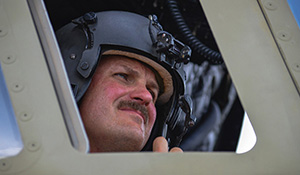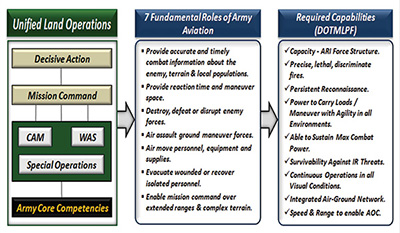
From the Aviation Branch Chief / MG Michael D. Lundy: Since Vietnam and the advent of Air Mobility, Army Aviation has proven to be an essential component of combined arms maneuver and the American way of war.
 U.S. ARMY PHOTO BY SGT JOSE RAMIREZ, CBT. AVN. BDE., 1ST ARMORED DIV.Army Aviation’s inherent speed, mobility, lethality and agility uniquely enable combined arms maneuver, wide area security and special operations, our Army’s core competencies, across the conflict continuum. Since its inception, Army Aviation has been a high-demand, ground-centric and globally-committed asymmetric capability for our Nation.
U.S. ARMY PHOTO BY SGT JOSE RAMIREZ, CBT. AVN. BDE., 1ST ARMORED DIV.Army Aviation’s inherent speed, mobility, lethality and agility uniquely enable combined arms maneuver, wide area security and special operations, our Army’s core competencies, across the conflict continuum. Since its inception, Army Aviation has been a high-demand, ground-centric and globally-committed asymmetric capability for our Nation.
Today, Army Aviation is fully committed in 36 countries around the world. Our Soldiers and leaders continue to excel in a high tempo environment to meet critical combatant command requirements. In addition to growing worldwide operational requirements in CENTCOM, AFRICOM, EUCOM and PACOM, we continue to support two contingency response forces, 24 combat training center (CTC) and Network Integration Evaluation (NIE) rotations annually, daily defense support to civil authority missions at home and air ground operations training with our 52 brigade combat teams (BCTs) at home station.
Equally as impressive, Army Aviation maintains a high level of readiness supporting worldwide operations while simultaneously executing internal training, Aviation Restructure Initiative (ARI) conversion, new equipment fielding and aircraft Reset. Our current readiness, responsiveness and overall reputation are made possible through the extraordinary efforts of our phenomenal Aviation Soldiers, leaders and Families.
 As the world becomes more complex and Army force structure gets smaller, it is critical that we continue to modernize and train our leaders to operate under all conditions and against all threats. Current global commitments, structure and funding reductions and known capability requirements dictate that we take extraordinary steps to maintain our unique, indispensable maneuver advantage to maximize national options and minimize risk to force. Fully executing the Aviation Restructure Initiative, continuing development and fielding of disruptive technologies to operate in all environments while resourcing training and leader development will reduce emerging vulnerabilities, increase employment options and mitigate risk to force.
As the world becomes more complex and Army force structure gets smaller, it is critical that we continue to modernize and train our leaders to operate under all conditions and against all threats. Current global commitments, structure and funding reductions and known capability requirements dictate that we take extraordinary steps to maintain our unique, indispensable maneuver advantage to maximize national options and minimize risk to force. Fully executing the Aviation Restructure Initiative, continuing development and fielding of disruptive technologies to operate in all environments while resourcing training and leader development will reduce emerging vulnerabilities, increase employment options and mitigate risk to force.
The ARI sets the foundational structure by 2019, and provides the means to enable this smaller Aviation structure to meet combatant commander (CCDR) requirements now and in the future. For a smaller Aviation force to enable the Army Operating Concept (AOC), we must complete ARI as planned and apply the associated savings to field a fully modernized fleet to maximize the capabilities of a smaller force structure. Although Future Vertical Lift (FVL) and its associated capabilities will dramatically increase our tactical, operational and strategic capabilities, we must bridge the 20-year gap leading up to our first FVL equipped brigades by modernizing our current capabilities while training tomorrow’s leaders today. ARI makes it possible.
The savings and cost avoidance gained by ARI allows us to complete the fielding of our modernized aircraft – AH-64E, CH-47F Block II, UH-60M/V, Gray Eagle and Shadow V2 – while fielding disruptive technologies and maintaining our training readiness to operate in all environments. Key capabilities that we need now and are able to resource through ARI include:
- Improved Turbine Engine Program (ITEP) and CH-47F Block II to give us the power to maneuver with agility in the objective area and enable operations in all environments.
- Common Infrared Countermeasure (CIRCM) program, Common Missile Warning System (CMWS) upgrades and advanced expendables to increase survivability against all infrared (IR) threats.
- Degraded Visual Environment (DVE) capabilities to enable continuous operations in all weather and all visibility conditions.
- Mission Command capabilities to conduct air-ground operations through a secure, integrated network.
- Home station flying hour programs and institutional training resources to maintain training readiness in Joint Combined Arms Operations while developing leaders that thrive in the increasingly complex environments.
Why it matters for the Army Operating Concept
“Army forces achieve surprise through maneuver across strategic distances and arrival at unexpected locations. Army forces have the mobility, protection and firepower necessary to strike the enemy from unexpected directions.” – Army Operating Concept 2014
The AOC describes how the Army must operate to win in a complex world and identifies Army Aviation as a foundational capability to the Army’s role in joint operations. For the AOC to succeed we must deliver our unique capability through the seven Fundamental Roles of Aviation; and these roles must be realized through training and modernization. Winning in a complex world requires key Aviation capabilities to enable Army Core Competencies.
Training and Leader Development
While it is critical that we equip our Soldiers with advanced technologies to meet the unknown and win, it is even more important that we invest in their training. Without continued investment in training and leader development as our highest priority, we will not retain the required readiness to meet demands, and we mortgage our future with cohorts of leaders that do not reach the level of competence required for the profession.
We must maximize every training resource and opportunity towards clearly defined performance goals to measure progress and proficiency. We must train under the most rigorous conditions to create the required complexity needed to maintain readiness to meet CCDR demands. We must make practice as hard as the real game by conducting multiple repetitions with changing variables to build versatility, experience, and agility while inducing rapid condition changes to build adaptability, initiative, and decision making. We must continue to drive innovative training approaches and leverage both the live and virtual training environments at home station and at CTCs to enable low-risk replication of high-risk conditions to drive problem solving and risk management.
To do this, we have to invest. We must resource training and leader development to drive challenging, multi-echelon, combined arms training to achieve collective, battalion level proficiency in complex air ground operations. This investment will ensure that our most important weapon system, agile and adaptive leaders and Soldiers, will remain unmatched in their ability to thrive in the unknown, unknowable and ever changing conditions described in the AOC.
Bridge to the Future
Using ARI savings to invest in critical capabilities now reduces risk and enables the AOC while we continue to pursue FVL. FVL aircraft will be a game changing capability that provides enhanced speed, range and payload to fully execute all operations specified in the AOC, allowing Army Aviation to operate in the tactical, operational and strategic levels of war. Through innovative interim solutions in materiel, training and doctrine, we can seize, retain and exploit the initiative in the period leading up to FVL.
Our Soldiers on the ground need Army Aviation in the fight 24/7, under all conditions and against all threats. We must be able to cross the line of departure with the Infantry without delaying for weather or degraded visibility conditions. To maintain the asymmetric advantage against evolving adversaries, we need to be able to see and kill with precision at extended ranges in all visual, physical and threat environments. By overlaying disruptive technologies on the foundational base provided by ARI, Army Aviation will enable the maneuver commander to dictate the terms of operations and take the fight to the enemy at the time and place of our choosing, not just when conditions are favorable.
Army Aviation provides an asymmetric advantage for our nation and presents multiple dilemmas for our enemies. Successfully executing ARI, fielding our modernized fleet with game changing disruptive technologies, and underpinning it all with highly trained leaders will enable our Army to dictate the terms of operations anywhere in the world.
Above the Best!
MG Michael D. Lundy is the Army Aviation branch chief and commander of the U.S. Army Aviation Center of Excellence and Fort Rucker, AL.








